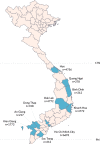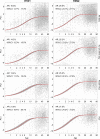Age-seroprevalence curves for the multi-strain structure of influenza A virus
- PMID: 34795239
- PMCID: PMC8602397
- DOI: 10.1038/s41467-021-26948-8
Age-seroprevalence curves for the multi-strain structure of influenza A virus
Abstract
The relationship between age and seroprevalence can be used to estimate the annual attack rate of an infectious disease. For pathogens with multiple serologically distinct strains, there is a need to describe composite exposure to an antigenically variable group of pathogens. In this study, we assay 24,402 general-population serum samples, collected in Vietnam between 2009 to 2015, for antibodies to eleven human influenza A strains. We report that a principal components decomposition of antibody titer data gives the first principal component as an appropriate surrogate for seroprevalence; this results in annual attack rate estimates of 25.6% (95% CI: 24.1% - 27.1%) for subtype H3 and 16.0% (95% CI: 14.7% - 17.3%) for subtype H1. The remaining principal components separate the strains by serological similarity and associate birth cohorts with their particular influenza histories. Our work shows that dimensionality reduction can be used on human antibody profiles to construct an age-seroprevalence relationship for antigenically variable pathogens.
© 2021. The Author(s).
Conflict of interest statement
The authors declare no competing interests.
Figures





References
-
- Boni, M. F., Mølbak, K. & Krogfelt, K. A. in The Handbook of Infectious Disease Data Analysis (eds Held, L., Hens, N., O’Neill, P. & Wallinga, J.) Ch. 15 (Taylor & Francis, 2020).
Publication types
MeSH terms
Substances
Grants and funding
LinkOut - more resources
Full Text Sources
Medical

